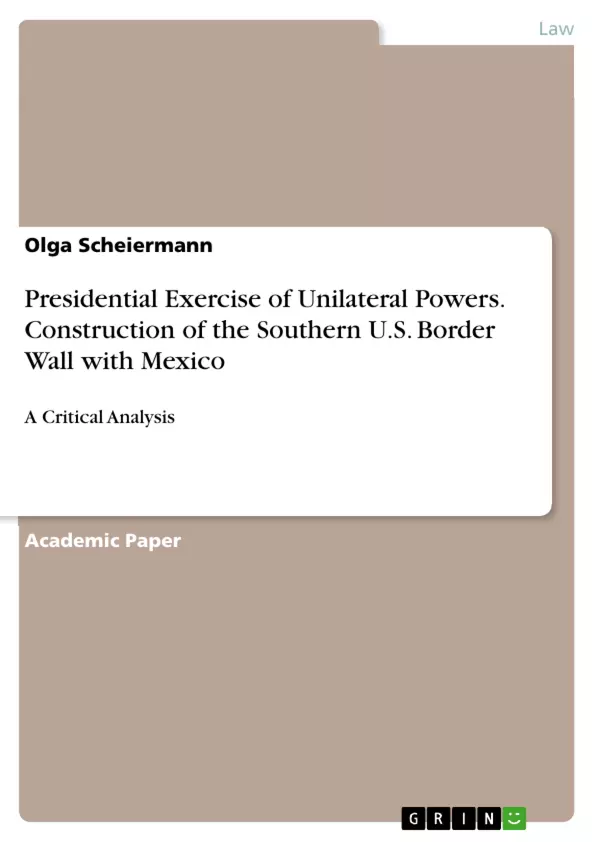This paper intends to prove the hypothesis that the (over)use of executive powers undermines the long-term confidence in the institution of the president, as well as usurping the legislative branch incorporated by the U.S. Congress and dramatically shatters the system of checks and balances. On January 25, 2017, Trump signed an executive order, entitled "Border Security and Immigration Enforcement Improvements", aiming at enhancing the enforcement of border security along the US-Mexican border by way of the construction of a 2,000-mile border wall.
After losing a fight with the Democratic-led House concerning the identified expenses of 8.1 billion for the wall, President Trump declared on February 15, 2019, a national emergency concerning the situation on the southern border of the United States under the National Emergency Act (NEA). By doing so, President Trump could have eventually undermined the legislative branch, as Congress traditionally holds the power of the purse. On ground of potential infringement of the Appropriations Clause of the Constitution and the Administrative Procedure Act (APA), the Congress passed a joint resolution to void the President’s National Emergency Declaration, which was however vetoed by the President himself.
The issue with the construction of the US-Mexican border wall is deeply rooted in the power struggle of both the executive branch (the president, including his subordinate institutions from the government, most notably the White House and the Cabinet) and the legislative branch (the two chambers of the Congress, the House of Representatives and the Senate). This emergency declaration could have infringed one of the basic principles of the separation of powers as manifested and practised in the US constitutional law, enabling the president to act independently, ultimately disregarding constitutional allocation on funding matters, as in the prevailing case.
Inhaltsverzeichnis (Table of Contents)
- States of emergency
- Introduction
- Historical background
- Early U.S. history
- The New Deal
- Post-World War II
- The contemporary use of executive orders
- The legal framework
- Constitutional provisions
- The National Emergency Act
- The Youngstown Sheet & Tube Co. v. Sawyer framework
- The southern U.S. border wall with Mexico
- The political context
- The legal challenges
- The impact on immigration policy
- Conclusion
Zielsetzung und Themenschwerpunkte (Objectives and Key Themes)
This work provides a critical analysis of the presidential exercise of unilateral powers in the United States, specifically focusing on the example of the southern U.S. border wall with Mexico. It explores the historical background, legal framework, and contemporary use of executive orders in the context of states of emergency. The aim is to evaluate the constitutionality and implications of the president's actions in a complex political environment.
- The historical evolution of executive power in the United States
- The legal framework governing the president's use of unilateral powers, particularly in times of emergency
- The application of the Youngstown Sheet & Tube Co. v. Sawyer framework to contemporary issues
- The political context surrounding the construction of the border wall
- The legal challenges to the border wall and their impact on immigration policy
Zusammenfassung der Kapitel (Chapter Summaries)
- Introduction: This chapter sets the stage for the analysis by introducing the topic of presidential unilateral powers in the context of states of emergency. It highlights the importance of understanding the historical background, legal framework, and contemporary use of executive orders.
- Historical background: This chapter provides a comprehensive overview of the historical evolution of executive power in the United States, covering key periods like the early U.S. history, the New Deal, and the post-World War II era. It examines how the president's power has expanded and contracted over time, emphasizing the role of significant events and landmark cases.
- The contemporary use of executive orders: This chapter delves into the legal framework surrounding the president's use of unilateral powers in the 21st century. It focuses on the constitutional provisions relevant to executive orders, including the National Emergency Act and the Youngstown Sheet & Tube Co. v. Sawyer framework. This section offers insights into the legal tools available to the president and the limits on their authority.
- The southern U.S. border wall with Mexico: This chapter examines the specific case of the border wall, exploring the political context surrounding its construction, the legal challenges it faces, and its potential impact on immigration policy. It provides a nuanced analysis of the complex factors involved in this contentious issue, considering both the domestic and international implications.
Schlüsselwörter (Keywords)
The main keywords and focus topics of this work include presidential power, unilateral powers, executive orders, states of emergency, the National Emergency Act, the Youngstown Sheet & Tube Co. v. Sawyer framework, constitutional law, immigration policy, border security, and the southern U.S. border wall with Mexico. These terms represent the central concepts and research focuses of the analysis, offering a comprehensive understanding of the topic.
- Quote paper
- Olga Scheiermann (Author), 2019, Presidential Exercise of Unilateral Powers. Construction of the Southern U.S. Border Wall with Mexico, Munich, GRIN Verlag, https://www.hausarbeiten.de/document/1000146


